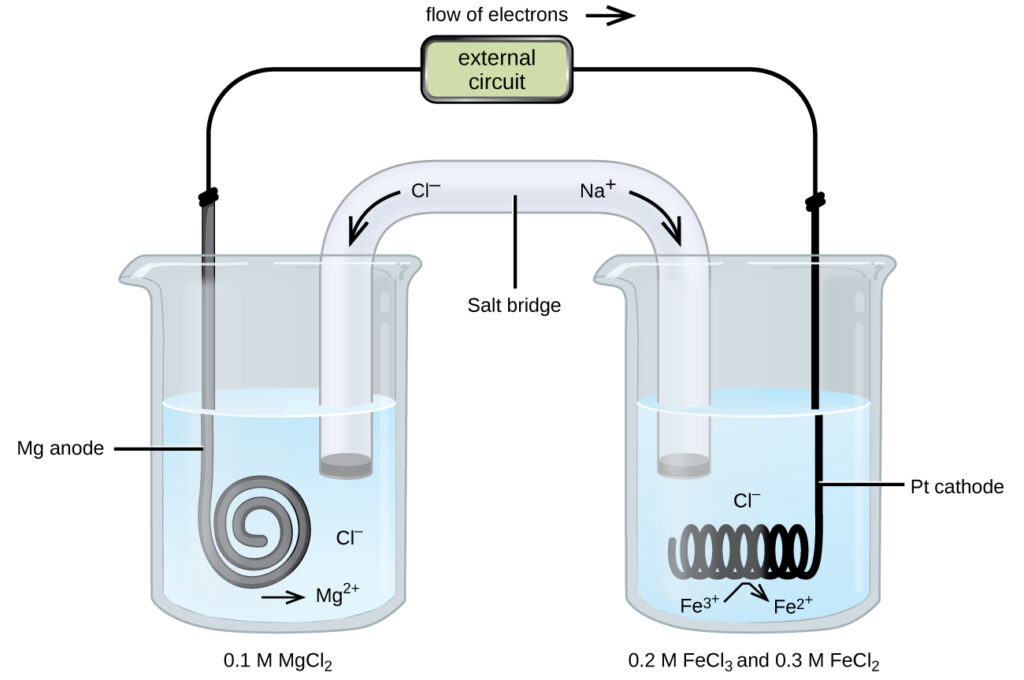Abbreviated symbolism is commonly used to represent a galvanic cell by providing essential information on its composition and structure. These symbolic representations are called cell notations or cell schematics, and they are written following a few guidelines:
- The relevant components of each half-cell are represented by their chemical formulas or element symbols
- All interfaces between component phases are represented by vertical parallel lines; if two or more components are present in the same phase, their formulas are separated by commas
- By convention, the schematic begins with the anode and proceeds left-to-right identifying phases and interfaces encountered within the cell, ending with the cathode
A verbal description of the cell as viewed from anode-to-cathode is often a useful first-step in writing its schematic. For example, the galvanic cell shown in the previous page consists of a solid copper anode immersed in an aqueous solution of copper(II) nitrate that is connected via a salt bridge to an aqueous silver(I) nitrate solution, immersed in which is a solid silver cathode. Converting this statement to symbolism following the above guidelines results in the cell schematic:
$$Cu(s)\;|\;1\;M\;Cu(NO_3)_2(aq)\;||\;1\;M\;AgNO_3(aq)\;|\;Ag(s)$$
Consider a different galvanic cell (see the figure below) based on the spontaneous reaction between solid magnesium and aqueous iron(III) ions:
| net cell reaction: | $Mg(s)+2Fe^{3+}(aq)⟶Mg^{2+}(aq)+2Fe^{2+}(aq)$ |
| oxidation half-reaction: | $Mg(s)⟶Mg^{2+}(aq)+2e^-$ |
| reduction half-reaction: | $2Fe^{3+}(aq)+2e^-⟶2Fe^{2+}(aq)$ |
In this cell, a solid magnesium anode is immersed in an aqueous solution of magnesium chloride that is connected via a salt bridge to an aqueous solution containing a mixture of iron(III) chloride and iron(II) chloride, immersed in which is a platinum cathode. The cell schematic is then written as
$$Mg(s)\;|\;0.1\;M\;MgCl_2(aq)\;||\;0.2\;M\;FeCl_3(aq),\;0.3\;M\;FeCl_2(aq)|\;Pt(s)$$
Notice the cathode half-cell is different from the others considered thus far in that its electrode is comprised of a substance (Pt) that is neither a reactant nor a product of the cell reaction. This is required when neither member of the half-cell’s redox couple can reasonably function as an electrode, which must be electrically conductive and in a phase separate from the half-cell solution. In this case, both members of the redox couple are solute species, and so Pt is used as an inert electrode that can simply provide or accept electrons to redox species in solution. Electrodes constructed from a member of the redox couple, such as the Mg anode in this cell, are called active electrodes.

A galvanic cell based on the spontaneous reaction between magnesium and iron(III) ions.
Writing Galvanic Cell Schematics
A galvanic cell is fabricated by connecting two half-cells with a salt bridge, one in which a chromium wire is immersed in a 1 M CrCl3 solution and another in which a copper wire is immersed in 1 M CuCl2. Assuming the chromium wire functions as an anode, write the schematic for this cell along with equations for the anode half-reaction, the cathode half-reaction, and the overall cell reaction.
Solution
Since the chromium wire is stipulated to be the anode, the schematic begins with it and proceeds left-to-right, symbolizing the other cell components until ending with the copper wire cathode:
The half-reactions for this cell are
| anode (oxidation): | $Cr(s)⟶Cr^{3+}(aq)+3e^-$ |
| cathode (reduction): | $Cu^{2+}(aq)+2e^-⟶Cu(s)$ |
Multiplying to make the number of electrons lost by Cr and gained by Cu2+ equal yields
| anode (oxidation): | $2Cr(s)⟶2Cr^{3+}(aq)+6e^-$ |
| cathode (reduction): | $3Cu^{2+}(aq)+6e^-⟶3Cu(s)$ |
Adding the half-reaction equations and simplifying yields an equation for the cell reaction:
$2Cr(s)+3Cu^{2+}(aq)⟶2Cr^{3+}(aq)+3Cu(s)$Check Your Learning
Omitting solute concentrations and spectator ion identities, write the schematic for a galvanic cell whose net cell reaction is shown below.